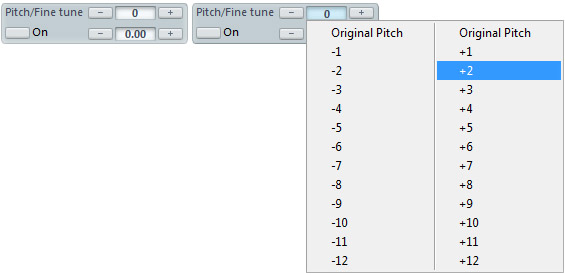Change key of a song (pitch shift, transpose) with Phrase Trainer 2
Transposing in Phrase Trainer 2 works in real-time which means you can change the tonality of music (or any audio file) as it is being played.
Click the upper ‘minus’ button to lower the key (pitch) of the song or the ‘plus’ button transpose to a higher pitch. The same can be done using your computer keyboard ‘Page up’ and ‘Page down’ keys. Or click pitch indicator to choose from a popup menu.
Click ‘On’ above to enable/disable pitch processing of the audio.
Key can be transposed in range from – 12 semitones (an octave down) to 12 semitones (an octave up) without changing the speed of the music.
Also pitch can be changed in finer increments called cents. To do so click lower ‘minus’ and ‘plus’ buttons.
All is done in real-time with MP3, Wave, Wma,Ogg, FLAC, midi and AAC/M4A files on your computer.
What is the use of transposing?
- To practice playing at different keys
- To play along any song in any key you want
- To transpose music to suit tonal range of your voice if you are a singer
I would like to have changed files on my Mp3 player or phone,is that possible?
Yes it is, just use the ‘Save file as’ function under ‘File’ submenu of the main menu where you can choose between a number of export options (wav,mp3,ogg,wma):
What is a semitone anyway?
A semitone, also called a half step or a half tone, is the smallest musical interval commonly used in music. It is defined as the interval between two adjacent notes in a 12-tone scale.
Or in plain English it is the distance between two neighboring frets on the guitar or keys on the piano (counting the black keys in too).
Cent?
Like with money only with musical notes, that is 1/100 of a semitone.
Why would anyone want to change pitch in cents (1/100 of a semitone)?
Although it may sound unnecessary, and rightly so because human ear can barely recognize such small changes, it comes in handy more often than one would expect. For example many old recordings (not very old but from days before all kinds of digital equipment became accessible) were often just barely out of tune, which is enough to frustrate anyone who wants to play along. You take your instrument willing to jam along a tune and soon find out that no matter how you tune the instrument you always sound out of tune. It is not your fault, the song itself is slightly below or above the pitch it was supposed to be in. That is were you might wish to re-tune a song just slightly so that it fits in.
Or other example which occurs with sax or other wind instruments (I’m told) is that players often find their instruments to be slightly out of tune, so it is more convenient to readjust the song than the instrument itself.
Why does music sound strange when shifted too much?
There is a number of reasons, most of them highly mathematical/scientific, but one obvious is that when a song is transposed its rhythm section, that is to say drums and other percussions, gets transposed too which would otherwise have remained unchanged if the band just decided to play song in a different key. So it is drums for the most part that add to the ‘strangeness’ of transposed song.
That is interesting! How is it done actually if not a secret?
Hm, don’t ask…

